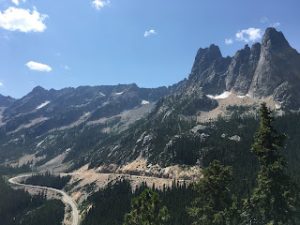Leander Anderegg (Hille Ris Lambers lab) just published a paper on shotgun ecology in Global Change Biology. You can learn more about Leander’s research on his website, and follow him on Twitter – @leanderegg
In the American Southwest, drought is a way of life. My hometown in southwest Colorado receives an average of 12 inches of rain a year (Seattle averages almost 4 times that). And water (or lack thereof) is such a strong aspect of the landscape that you can feel it getting wetter as you drive up a mountain from the low elevation scrub woodlands to the subalpine forests. The sparse low elevation ‘trees’ look as tortured and windswept as the red rocks on which they grow, while the mossy and majestic high elevation forests hold some of the same tree species you can find on the Olympic Peninsula. In the La Plata Mountains in southwest Colorado, precipitation nearly quadruples from the foot of the mountain to treeline, and vegetation patterns precisely reflect this change. Because of such strong climatic gradients across elevation, descending a mountain in the southern Rockies is akin to looking into the future. The Southwest is getting hotter and drier, so in some respects one can predict a location’s ecological future just by looking downhill. Because water is such a strong control on the vegetation of the region, climate change is almost certain to push many plants uphill, forcing them to shift their geographic range or go locally extinct.
In our recent paper in Global Change Biology, Dr. Janneke Hille Ris Lambers and I took advantage of this mountainous drought stress gradient to explore the mechanisms by which water stress controls the low elevation/dry range edge of two common, widespread, and economically important tree species: ponderosa pine (Pinus ponderosa) and trembling aspen (Populus tremuloides). We wanted to know how these two tree species adjusted their physiology to deal with increasing water stress going down the mountain, so that we could infer how their dry range boundary will move uphill as the region warms.
Last summer, with the help of two undergrad field assistants and a shotgun, I collected branches from across the elevation range of both species in the La Plata Mountains in southwestern Colorado. We measured how water stressed trees were at the height of the summer, and quantified how drought physiology changed in both species moving from the low/dry range margin uphill to wetter parts of their range.
 |
| It ain’t science unless there’s a shotgun. We brought in superior fire power to collect branch samples from trembling aspen and ponderosa pine trees that were often more than 90 feet tall. |
Six hundred shotgun shells later, what we found was startling. Ponderosa pine and trembling aspen respond to increasing water stress at their dry range boundaries in opposite ways. When things get dry, trembling aspen opts to grin and bear it (so to speak), growing stronger wood and leaves that can still function at high levels of drought stress. But by beefing up to continue moving water when things get dry, aspens have to invest more resources in each unit of tissue they grow, and end up growing much more slowly at low elevations. Meanwhile, ponderosa pine invokes the better part of valor when times get tough. Instead of beefing up its tissues to fight with dry soil, ponderosa stops using water. It closes the stomata on its needles (the little mouth-like valves that control how much water can evaporate from the needle) and avoids drought by waiting it out. However, because low elevation ponderosas are quick to hang up the physiological “gone fishing” sign, they end up sitting it out through much of the growing season. As a consequence, their growth rates are much much lower than ponderosas growing higher up the mountains.
This is all well and good, but what does it mean? Well, we think that the drastically different strategies that these two species employ at their dry range edge will lead to rather different range dynamics over the coming century. Both species will probably shift uphill eventually, but they will likely do it at different rates and in response to different types of climatic changes. Aspens, with their grin and bear it strategy, will probably do pretty well against the gradual, long term increases in mean drought stress. But their strategy of using water even during drought leaves them open to catastrophic failure when things get really dry. In the first ‘global-change-type drought’ (a really hot drought, often considered the drought of the future) that hit Colorado in 2002, low elevation aspens broke their hydraulic system and died off en-mass near aspen’s dry range edge. We expect this pattern to continue: aspens will do fine during normal years even as things get warmer, but when major droughts hit aspens may die off rapidly, contracting uphill in fits and starts over the next century.
 |
| Sunset on low elevation aspen trees that died during the 2002 drought, likely the herald of an apsen range shift. |
Meanwhile, we expect a more gradual shift uphill for ponderosa pine. Ponderosa’s risk-averse water use strategy protects it from most of the catastrophic drought mortality that afflicts aspen (ponderosas weathered 2002 without much problem). But their caution comes at the cost of growth during average years. As a consequence, ponderosa pines may show long term decreasing growth trends that follow the long term climate trends in the region (particularly trends in spring climate, when they do most of their growing). Because ponderosa trees can live for over 500 years, adult trees may linger at low elevations for a long time (barring a bark beetle outbreak, which is a whole different story), but we suspect that low elevation populations will slowly become unsustainable.



